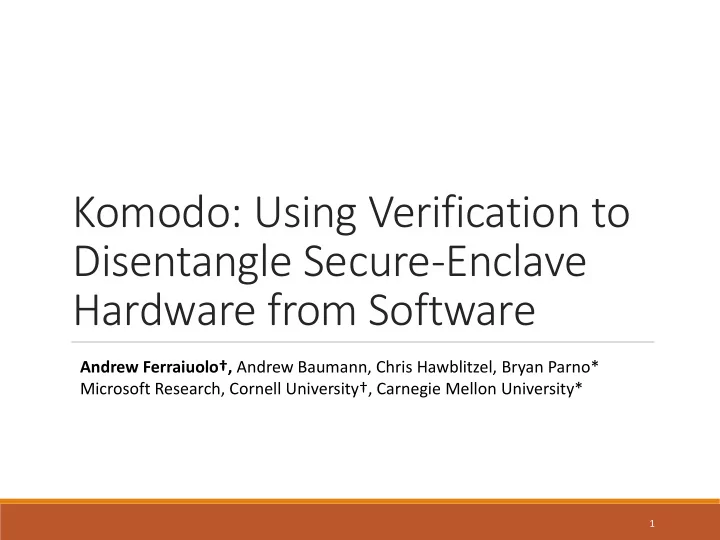

Komodo: Using Verification to Disentangle Secure-Enclave Hardware from Software Andrew Ferraiuolo†, Andrew Baumann, Chris Hawblitzel, Bryan Parno* Microsoft Research, Cornell University†, Carnegie Mellon University* 1
Secure Remote Computation Application + Secrets Application/Data Owner OS, Hypervisor, Other SW CPU Memory Remote Machine 2
Intel SGX EnclaveEntry: mov fs:[Tcs],rbx Secret mov fs:[CSSA],eax cmp eax, 0 jne ExceptionEntry Data mov r10,fs:[ResAdr] cmp r10,0 je @F jmp r10 @@:mov rcx, r8 mov rdx, r9 mov r8, rbx Enclave Memory encryption Remote attestation Reference SGX instructions Monitor Implement a reference monitor OS Memory (untrusted) 3
SGX Limitations – Slow to Evolve Software developers must wait for Intel to make changes Change is necessary ◦ SGX1 had no support for dynamic memory management ◦ SGX2 was announced in 2014. Still no implementation! SGX instructions are primarily microcode ◦ Software at the slow pace of hardware! Software Development Time Hardware 4
SGX Limitations – Root of Trust? SGX is complex ◦ Approaching a microkernel in hardware Hardware is no more trustworthy than software ◦ Hardware vulnerabilities: f00f, cache poisoning, VT-D vuln., others ◦ Purely axiomatic basis for trust SGX vulnerabilities have already been found (CVE-2017-569) 5
Komodo Enclave management in software Evolve independently of hardware Trust through formal verification 6
Komodo Architecture Komodo monitor software: Enclave proc. User ◦ Mimics SGX instructions ◦ Minimal hardware requirements ◦ Supported by commercial processors Komodo Untrusted OS monitor CPU / HW Attest. key Hardware Requirements: Mem isolation ◦ Isolated memory ◦ Encryption (Intel/AMD), partitioning (ARM) ◦ Key-generation for attestation ◦ Trusted Platform Module (many processors) ◦ Protection modes for enclave, monitor ◦ Machine mode (RISC-V), TrustZone (ARM) 7
Prototype on ARM TrustZone Normal world Secure world User mode: User apps Enclaves Privileged modes: Untrusted OS Komodo Monitor Secure-world memory is isolated from normal world. 8
OS Monitor Calls: Creation INIT_ADDRSPACE() PageDB INIT_L2PT() Entry Context MAP_SECURE() / (PC) MAP_INSECURE() INIT_THREAD() L1PT: FINALISE() State: Final Init L2PT Measurement Data 9
OS Monitor Calls: Entry ENTER() / RESUME() PageDB Interrupt/ CPU: Exception Entry Context PC (PC) GPRs L1PT L1PT: State: Final 10
Enclave Execution Compute on data in its secure pages Communicate with outside world ◦ Read/write insecure pages ◦ Register arguments/return values Komodo enclave API ◦ Create/verify attestations ◦ Secure source of randomness ◦ Map/unmap spare pages ◦ Exit thread 11
Verification Implementation 1) Prove Komodo conforms to specification of correct execution ◦ Simpler, more abstract Correctness Specification 2) Prove that correctness spec enforces security properties Security Properties 12
Security Properties Enclaves are protected from an OS + malicious enclave adversary: ◦ Confidentiality – enclave secret state cannot leak to adversary ◦ Integrity – adversary cannot tamper with enclave trusted contents Formalized as noninterference – adversarially-observable outputs are purely determined by adversarially-controlled inputs Declassified to OS: exception type, dynamic allocation, return values, and insecure memory ◦ Precisely captures what information is released 13
Verification Approach Trusted Komodo implementation Untrusted Komodo (annotated assembly) abstract spec (~2k LOC) Supporting ARMv7 ISA proofs model (~1.5k LOC) code proof Dafny, Z3 ✓ komodo.S 14
Microbenchmark results Operation Cycles Null SMC 123 Enter 496 Resume 625 Enter + Exit 738 Prototype on Raspberry Pi 2. ◦ Bootloader: loads monitor into secure world memory + sets exception vectors cf. SGX: ~7100 cycles for enter + exit [Eleos, Eurosys’17] ◦ In part because RasPi has a slower clock rate (900MHz vs 2GHz+ ) 15
Performance: Notary Application 80 70 60 50 Time (ms) 40 30 20 10 Komodo enclave Linux process 0 4 8 16 32 64 128 256 512 Input size (kB) 16
Verification Effort Total verification effort – 2 person-years Source lines of code : Spec Impl Proof Total 4,446 2,710 18,655 Security 175 Correctness 795 ARM 1,174 Other 2,302 17
Adaptability Motivation: software can evolve more quickly than hardware SGX2 extends SGX1 with dynamic memory management ◦ Specified three years ago . Still no implementation We extended Komodo with dynamic memory in 6 person-months! ◦ Three weeks to re-establish security proofs 18
Related Work CertiKOS / seL4 ◦ Implement fully-featured microkernels ◦ Prove correctness, security properties ◦ Komodo is a simpler system, supports attestation Sanctum ◦ Proposes RISC-V-based hardware that meets the needs of Komodo 19
Lessons Learned A small code base is not a substitute for verification. ◦ Verification caught real bugs in our implementation Trusted components require extra diligence ◦ We found bugs in trusted/unverified components Verification tools can still improve ◦ Timeouts / proof instability 20
Conclusion SGX defends against a powerful threat-model, but it has limitations: ◦ Slow to change ◦ Requires axiomatic trust Komodo improves evolvability and security ◦ Implemented in software with minimal hardware requirements ◦ First formally-verified implementation of attested enclaves Verification of software enclaves is tractable, permits evolution ◦ 2 person-years worth of total effort ◦ 6 person-months to add SGX2-like dynamic memory management https://github.com/Microsoft/Komodo 21
Recommend
More recommend